|
|
Sections on this page: Outreach / Education | HACCP | Presentations | Book Chapters / Sections | Journal Articles
Outreach / Education back to top
 |
Seafood and You. New York Sea Grant Fact sheet, Stony Brook, NY. July 2016. (pdf)
This fact sheet outlines what’s in seafood and helps guide you in making healthy decisions.
|
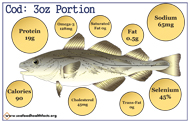 |
Seafood Nutrition Postcards. New York Sea Grant mini postcard fact sheets, Stony Brook, NY. July 2016. (Click here to view cards)
A series of postcards highlighting nutritional information for various popular seafood choices. The back of each card contains additional resources.
|
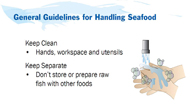 |
Seafood Card Series. New York Sea Grant mini fact sheets, Stony Brook, NY. July 2016. (Click here to view sets)
A series of miniature (business card) fact sheets on various topics surrounding seafood safety and nutrition.
|
 |
Seafood Safety (HACCP for Consumers). New York Sea Grant fact sheet, Stony Brook, NY. July 2016. (pdf)
A brochure geared towards educating consumers on what the seafood industry does to ensure that their seafood is wholesome and safe.
|
 |
Seafood Science Curriculum. New York Sea Grant, Stony Brook, NY. August 2017. (pdf)
This curriculum provides a general outline for food science and more specific information on seafood science. Seafood Science is separated into the 4 P’s of seafood science and meant to educate teachers on what it is a seafood scientist must do to produce, preserve, protect and perfect the seafood products they make.
The curriculum is available to use as a resource to help include seafood science in the classroom and supplement the lesson plans produced with more detailed information, allowing for expansion on the topics.
|
 |
Aquaculture Curriculum. New York Sea Grant, Stony Brook, NY. August 2017. (pdf)
This curriculum provides a general overview of aquaculture, elaborating on seafood security and the need for aquaculture, the stages of aquaculture, the key considerations a farmer must think about and the various types of aquaculture.
The curriculum is available to use as a resource to help include aquaculture topics in the classroom and supplement the lesson plans produced with more detailed information, allowing for expansion on the topics.
|
 |
Lesson Plan: Becoming a Fish-Farmer (Aquaculturist). New York Sea Grant, Stony Brook, NY. August 2017. (pdf)
Becoming an aquaculturist is a hands on creative activity that requires student to think outside the box to create their own miniature aquaculture farm. It provides a background story to excite and entice the students and then provides the steps you can take to have the students create their own farm systems.
This activity has optional topics for expansion, which include the importance of nurseries and standing up to storms. Questions to facilitate discussion are provided and the information provided in the curriculum can help teachers better facilitate these discussions. Although the activity was designed for grades 8-12, the lesson can be geared towards any age group.
|
 |
Lesson Plan: A Spin on Seafood. New York Sea Grant, Stony Brook, NY. August 2017. (pdf)
This trivia activity can be incorporated into the classroom. While originally designed and intended for 7-12th grade it can easily be adapted to any grade level by adding additional questions and/or removing some of the detail from the provided answers/curriculum.
The activity involves the use of a spinning wheel with 5 trivia categories (Fisheries, Aquaculture, Seafood Science, Seafood Sustainability, Seafood Safety) and 5 go fish sections. When a student lands on “Go Fish” they can fish for a card (19 total), which contain information on fish species as well as some other undesirables that can make their way into the waterways.
This activity is a great starting point for discussion on fish biology, sustainability, conservation, aquaculture, safety etc. of a variety of seafood species. The information provided in the curricula can help teachers better facilitate these discussions.
|
 |
Sustainable Seafood Guidance Booklet. New York Sea Grant, Stony Brook, NY. August 2017. (pdf)
This booklet outlines the general criteria used in assessing sustainability by some of the larger 3rd party certifiers and comparing these criteria to current regulations. The guide is meant to provide some more detailed information on seafood sustainability and how uncertified fisheries, farms or fishermen compare to certified fisheries through regulatory compliance.The guide also discusses some of the underutilized species that are available in NY.
The resource is meant to provide more information for consumers and help the industry make decisions with regards to sustainably grown, harvested and sourced seafood in the state. While the document was geared towards NY businesses and residents much of the information provided on 3rd party certifiers and federal regulations are applicable across state lines.
|
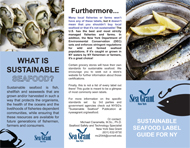 |
Seafood Label Guide for NY. New York Sea Grant, Stony Brook, NY. August 2017. (pdf)
This trifold outlines some of the sustainability labels that can be found on seafood products sold in NY. Information on the different certifying bodies are included and some information on local fisheries. This resource is meant to help consumers identify and choose sustainable seafood.
|
 |
NY Seafood Infographic. New York Sea Grant, Stony Brook, NY. August 2017. (pdf)
This infographic outlines the benefits of NY Seafood and provides a visual depiction of many of the species available locally.
|
 |
3rd party vs. Gov. Comparison Card. New York Sea Grant, Stony Brook, NY. August 2017. (pdf)
This card provides a quick and general comparison of 3rd party certifications and government regulations. This general overview is meant to be a starting point for consumers and the industry to understand how sustainable fisheries are managed and the different organizations involved. This resource provides a general overview of what is provided in greater detail in the Guidance Booklet.
|
 |
Seafood Eat Food Marketing Resources. New York Sea Grant, Stony Brook, NY. 2018. (Click Here)
New York Sea Grant in collaboration with the National Aquaculture Association developed free customizable seafood marketing resources to assist in branding and marketing your seafood products and dishes.
|
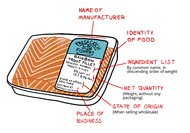 |
Seafood Processing and Marketing Guides. New York Sea Grant, Stony Brook, NY. 2021. (Click Here)
New York Sea Grant coordinated a Seafood Processing and Marketing Task Force with Federal, State, and Local agencies, industry groups and extension personnel to address hurdles and opportunities for alternative marketing strategies for seafood in NY State.
|
 |
QPX Disease in Hard Clams. New York Sea Grant fact sheet, Stony Brook, NY, July 2003. (pdf)
This fact sheet outlines the biology, significance to NY hard clams and status for control of the QPX parasite in NY.
|
 |
The Economic Contribution of the Sport Fishing, Commercial Fishing, and Seafood Industries to New York State. Executive Summary. 8pp. (pdf)
This report from April 2001 summarizes the economic contribution of the seafood, commercial fishing and sport fishing industries to the economy of New York State.
|
 |
Handling Your Catch: A Guide for Saltwater Anglers (pdf)
This guide offers the basics of good fish handling practices and photographs that show step-by-step methods for filleting or dressing a variety of marine sport fish are also included.
|
 |
Seafood Savvy: A Consumer's Guide to Seafood Nutrition, Safety, Handling and Preparation (pdf)
Seafood savvy was a booklet written with consumers in mind to help them better understand seafood products, their nutritional content, and how to use them safely and confidently.
|
HACCP-Related back to top
 |
Chapter Dissection. New York Sea Grant reference sheet, Stony Brook, NY. July 2016. (pdf)
This document highlights the different sections of each chapter of the FDA Seafood Hazards Guide to help you understand and interpret them better.
|
 |
Seafood HACCP in Phases. New York Sea Grant reference sheet, Stony Brook, NY. July 2016. (pdf)
This one page document walks one through the steps of developing and implementing a HACCP plan for their seafood facility.
|
 |
Seafood HACCP: Step by Step. New York Sea Grant reference sheet, Stony Brook, NY. July 2016. (pdf)
This document outlines the phases of developing and implementing a HACCP plan in detail. It will guide you step by step through developing a HACCP plan for your seafood facility.
|
 |
Hazard Analysis and Critical Control Point Training Curriculum 5th Edition, Editorial Committee: Dane Bernard, Bob Collette, Ken Gall, Kathy Hart, Don Kraemer, Bob Price, Steve Otwell and Donn Ward, National Seafood HACCP Alliance Publication SGR-127, Gainesville, FL, 2001, 252 pages. To order (click here).
|
 |
Sanitation Control Procedures for Processing Fish and Fishery Products Training Manual, Editorial Committee: B. Collette, C. Fernandes, G. Flick, K. Gall, G. German, D. Hicks, K. Hildebrand, M. Jahncke, D. Kraemer, B. Metz, M. Moody, K. Moore, S. Otwell, B. Price, T. Rippen, D. Ward, L. Weddig, S. Wilson, and K. Young, National Seafood HACCP Alliance Publication SGR-119, Gainesville, FL, 2000, 188 pages. (click here)
|
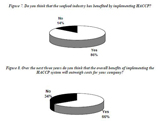 |
National Seafood Industry HACCP Implementation Survey Report, Ken Gall, New York Sea Grant Technical Report, Stony Brook, NY, April 2000, 65 pages. (pdf)
|
Presentations back to top
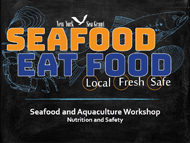 |
"Seafood Eat Food: Local Fresh Safe" (November 2016) Seafood and Aquaculture Workshop, Riverhead, NY (pdf)
Presentation on seafood nutrition, safety and consumer trends.
|
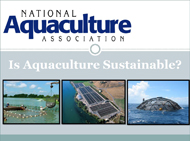 |
"Is Aquaculture Sustainable?" (November 2016) Seafood and Aquaculture Workshop, Riverhead, NY (pdf)
Presentation by the National Aquaculture Association
|
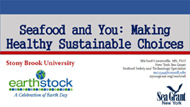 |
"Seafood and You: Healthy Sustainable Choices" (April 2016) Stony Brook University, Earthstock Celebration (pdf)
Presentation on seafood sustainability and nutrition. Goes through what must be considered when making sustainable choices.
|
Book Chapters/Sections back to top
 |
Specialty Seafood Products, Gall, K., Reddy, K and Regenstein, J. In: Marine and Freshwater Products Handbook, Edited by Roy E. Martin, Emily Paine Carter, George J. Flick Jr., and Lynne M. Davis, Technomic Publishing, Lancaster, PA, 2000, Pages 403-416.
|
Journal Publications back to top
Weidmann, Martin and Ken Gall. Listeria monocytogenes: A challenge for the smoked seafood industry in International Smoked Seafood Conference Proceedings, Alaska Sea Grant College Program Publication AK-SG-08-02, University of Alaska, Fairbanks, 2008, Pages 1-4.
Pivarnik, L., D. Hicks, M. Jahncke and K. Gall. Needs Assessment Survey of Sanitation, Good Manufacturing and Hygienic Training Practices for Food Processors, Wholesalers and Warehouse Operators, Food Protections Trends, Vol. 27, No. 5, 2007, Pages 400-408.
Gall, K., VN Scott, R. Collette, D. Hicks, and M. Wiedman. Implementation of Listeria Controls by Ready-to-Eat Seafood Processors Following a National Workshop Series, Food Protection Trends, Vol. 26, No.2, 2006, Pages 89-95.
Hu, Y. K. Gall, A. Ho, R. Ivanek, Y. T. Grohn, and M. Weidman. Daily Variability of Listeria Contamination Patterns in a Cold-smoked Salmon Processing Operation. J. Food Prot. Vol. 69, No. 9, 2006, Pages 2123-2133.
Industry Collaboration Advances Listeria Control in RTE Seafood Plants: An Interview with Ken Gall, New York Sea Grant and Smoked Seafood Working Group. Food Safety Magazine, Vol. 11, No.4, August/September 2005, Pages 52-55 and 63-66.
Scott, VN, M. Wiedmann, D.Hicks, R.Collette, M. Jahncke and K. Gall. Guidelines for Listeria Testing of Environmental, Raw Product and Finished Product Samples in Smoked Seafood Processing Facilities, Food Protection Trends, Vol. 25, No 1, 2005, pages 23-34.
Hicks, D, M. Weidmann, V. N. Scott, R. Collette, M. Jahncke, and K. Gall. Minimizing Listeria Contamination in Smoked Seafood: Training Plant Personnel. Food Protection Trends, Vol. 24, No. 12, 2004, Pages 953-960.
Jahncke, M, R. Collette, D. Hicks, M.Wiedmann, V.N. Scott, and K.Gall. Treatment Options to Eliminate or Control Growth of Listeria monocytogenes on Raw Material and on Finished Product for the Smoked Fish Industry. Food Protection Trends, Vol.24, No.8, 2004, Pages 612-619.
Lappi, VR, J. Thimothe, K. Nightingale, K. Gall, V.N. Scott and M. Wiedmann. Longitudinal Studies on Listeria in Smoked Fish Plants: Impact of Intervention Strategies on Contamination Patterns. Journal of Food Protection, 2004, Vol. 67, No. 11, Pages 2500-2514.
Lappi, VR, A. Ho, K. Gall and M. Wiedmann. Prevalence and Growth of Listeria on Naturally Contaminated Smoked Salmon Over 28 Days of Storage at 4 degrees C. Journal of Food Protection, 2004, Vol. 67, No. 5, Pages 1022-26.
Lappi, V.R., J. Thimothe, J. Walker, J. Bell, K. Gall, M.W. Moody, and M. Wiedmann. Impact of Intervention Strategies on Listeria Contamination Patterns in Crawfish Processing Plants: A Longitudinal Study. Journal of Food Protection, 2004, Vol. 67, No. 6, Pages 1163-1169.
Gall, KL, V.N. Scott, R.Collette, M. Jahncke, D. Hicks and M. Wiedmann. Implementing Targeted Good Manufacturing Practices and Sanitation Procedures to Minimize Listeria Contamination of Smoked Seafood Products. Food Protection Trends Vol. 24, No. 5, 2004, Pages 14-27.
Thimothe, J, K. Kerr Nightingale, K. Gall, V.N. Scott and M. Wiedmann. Tracking and Control of Listeria monocytogenes in Smoked Fish Processing Plants. Journal of Food Protection, Vol. 67, No. 2, 2004, Pages 328-341.
Hoffman, AD, Gall, KL, Norton, DM and Wiedmann, M. Contamination Patterns in the Smoked Fish Processing Environment and for Raw Fish, Journal of Food Protection, Vol. 66, No. 1, 2003, pages 52-60.
Adam D. Hoffman, Kenneth L. Gall and Martin Wiedmann, The Microbial Safety of Minimally Processed Seafood with Respect to Listeria monocytogenes in Microbial Safety of Minimally Processed Foods, Edited by John S. Novak, Gerald M. Sapers and Vijay K. Juneja, CRC Press, Boca Raton, FL, 2003, Pages 53-75.
Thimothe, J, J. Walker, V. Suvanich, K. Gall, M. Moody, and M. Wiedmann, Dectection of Listeria in Crawfish Processing Plants and in Raw, Whole Crawfish and Processed Crawfish (Procambarus spp.), Journal of Food Protection, Vol. 65, No. 11, 2002, Pages 1735-39.
Norton, DM, M.McCamey, K. Gall, J. Scarlett, K.Boor, and M. Wiedmann, Molecular Studies on the Ecology of Listeria monocytogenes in the Smoked Fish Processing Industry, Applied and Environmental Microbiology, Vol. 67, No. 1, 2001, Pages 198-205.
|